What Makes Photoshop So Expensive?
Why does the upcoming Adobe Photoshop CS5 cost $600? We tested out its features to find out what you’re paying for.
Get HDR Effects Without Multiple Images
If you look at the vibrant, glowing images from professional photographers and wonder why you can’t get the same colors in your own photos, it’s probably because they’re combining multiple exposures into one HDR image. Combining images that capture the shadows, the highlights, and what you’d consider the standard exposure for the scene means you can show bright sunlight in the background without bleaching or blackening out details in the foreground–your eye can see a much wider range of tones in an image than your camera can and HDR puts some of that back in your photos.
HDR is far from new, but it isn’t usually easy. There have been various add-ons and extras to simplify merging multiple exposures into HDR images in Photoshop or you could do it with the multi-step HDR tool in versions of Photoshop from CS2 onwards (or do it by hand with layers). The HDR Pro feature in CS5 gives you a lot more controls in a simpler interface, including making it easier to work with multiple exposures taken without a tripod. There’s also an option for faking an HDR image when you only have one exposure.
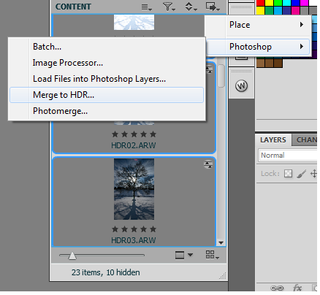
HDR is a demanding process. It’s one of the few areas we had any problems with in the beta (along with 3D) and you’ll have to wait for Photoshop to work through the sequence of steps to merge the images, but this is still far easier than the previous multi-step and manual processes. The HDR merge in CS5 is a little better at aligning multiple images and removing "ghosts" where the same feature moves between two exposures. The HDR Pro dialog shows you the exposure of the source images and which one it’s using as the reference for removing those errors–and you can pick a different source image by clicking it.
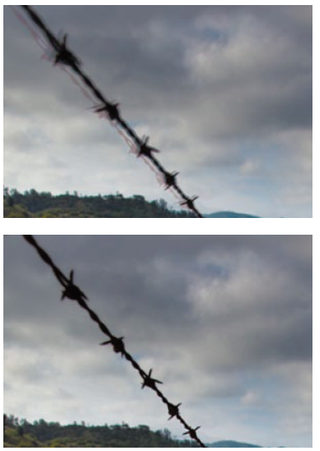
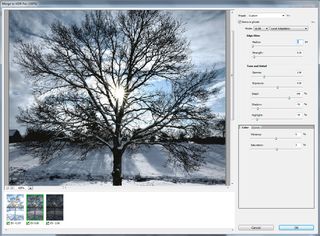
The default HDR image is weighted to look vivid but realistic–you can adjust how vibrant and saturated the colors are; tweak the exposure overall and the balance of tones in the shadows, highlights, and details; or control how much the edges of objects in the photo "glow" to get the specific effect you want.
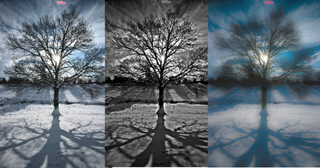
When you don’t have multiple exposures and your photo is dark or uninspiring, HDR Toning mimics the increased tonal range of HDR. The effects aren’t as good and you’ll have to spend more time tweaking the settings–unless you’re an expert, don’t expect the real look of HDR but you can certainly get more attractive images.
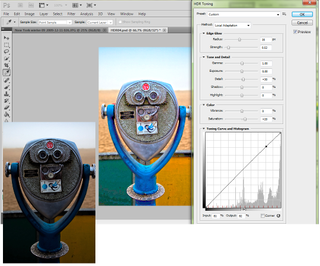
Sign up to get the BEST of Tom's Guide direct to your inbox.
Get instant access to breaking news, the hottest reviews, great deals and helpful tips.
Current page: Photoshop CS5 HDR Merge - Effect - How It Works - Tom’s Guide
Prev Page Photoshop CS5 Retouching Tools - How They Work - Tom’s Guide Next Page Photoshop CS5 Paint Tools - How They Work - Tom’s GuideMary Branscombe is an experienced freelance journalist, editor and author, who has been writing for more than three decades. Her work has appeared in The Financial Times, The Guardian, Tom's Guide, and many more. She has also written several novels — including the Cassidy At Large technomysteries — and two IT guides alongside her writing partner, Simon Bisson.
-
mitch074 Nice. Photoshop sure is quite the package.Reply
However, I wonder why, along with all the tools you cite, there is no mention made of the Gimp...? After all, it is available on Windows, Mac and Linux, it doesn't cost a dime, and it also includes:
- HDR effects (in script-fu): Tone Mapping and Exposure Blend
- painting effects (programmable brushes)
- GEGL (yes, 3D in Gimp)
- lens correction
Now, all of these aren't as advanced nor are they as easy to use as the Photoshop versions, but they are here and they work. For free. -
marybranscombe Mitch - to fit in as much information about Photoshop CS5, I only had room to mention a tiny fraction of all the image editing tools out there ;) I'm quite a fan of Paint.Net and Irfanview, personally...Reply -
mitch074 Paint.NET, iPhoto, WL Photo Gallery are not exactly professional-grade applications - while the Gimp (with colour profile management capabilities, layers-based approach, programmable filters, vector graphics capabilities, advanced stylus management, etc.) is, actually, used by some professionals... And a direct competitor to Photoshop.Reply
Thus why I found its absence (Paint.NET isn't quite there yet, it does have the merit of being free for use -but not open source- ) a bit surprising. -
Traciatim "Digital SLRs let you save files not just as JPEGs but in a RAW . . . "Reply
So does my point and shoot from 2002 . . . and (I believe all new) Interchangeable Lens Digital Cameras, and lots of point and shoots available today. You could have just said "Many Digital Cameras" rather than implying that Digital SLRs do something that other cameras don't, which is not true. -
marybranscombe Traciatim - true, but 1) the CS5 emphasis is very much on the DSLRs judging by the minimal list of cameras covered by the cusotm lens correction (and Adobe refers to only 275 cameras whose RAW formats are supported) and 2) my feeling is usually that point and shoot cameras with small lenses and sensors tend to need the in-camera processing to deliver good imagesReply -
cadder Photoshop is the ultimate consumer image editing tool. There are lesser tools sold by Adobe that will do for most people with digital cameras, and they are a lot less expensive- Photoshop Elements and Photoshop Lightroom. Of course Gimp and Irfanview are much cheaper options than that for the average person too.Reply -
anthropophaginian If it was for sale for half-price $300, I doubt sales would double. The same universities and design companies would buy it, but it would still be out of many consumers' price range. At this price range, with spreading of costs the time saved and final quality of the product will justify the price.Reply
...Also you're paying for the ostentatious value. -
punditguy Student discount FTW! Adobe Creative Suite Design Standard, $299 at Amazon. Won't be available until June 30, though...Reply -
Tomsguiderachel Traciatim"Digital SLRs let you save files not just as JPEGs but in a RAW . . . " So does my point and shoot from 2002 . . . and (I believe all new) Interchangeable Lens Digital Cameras, and lots of point and shoots available today. You could have just said "Many Digital Cameras" rather than implying that Digital SLRs do something that other cameras don't, which is not true.I would argue that most point and shoots today do not offer RAW. And, most interchangeable lens cameras ARE DSLRs (not all).Reply
